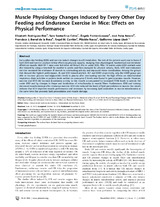Muscle Physiology Changes Induced by Every Other Day Feeding and Endurance Exercise in Mice: Effects on Physical Performance

Ver/
Autor
Rodríguez-Bies, Elizabeth
Santa-Cruz Calvo, Sara
Fontán-Lozano, Ángela
Peña Amaro, J.
Berral de la Rosa, Francisco José
Carrión, Ángel M.
Navas, Plácido
López-Lluch, Guillermo
Editor
Public Library Of Science (PLOS)Fecha
2010Materia
MicePhysiology
Muscle damage
METS:
Mostrar el registro METSPREMIS:
Mostrar el registro PREMISMetadatos
Mostrar el registro completo del ítemResumen
Every other day feeding (EOD) and exercise induce changes in cell metabolism. The aim of the present work was to know if
both EOD and exercise produce similar effects on physical capacity, studying their physiological, biochemical and metabolic
effects on muscle. Male OF-1 mice were fed either ad libitum (AL) or under EOD. After 18 weeks under EOD, animals were
also trained by using a treadmill for another 6 weeks and then analyzed for physical activity. Both, EOD and endurance
exercise increased the resistance of animals to extenuating activity and improved motor coordination. Among the groups
that showed the highest performance, AL and EOD trained animals, ALT and EODT respectively, only the EODT group was
able to increase glucose and triglycerides levels in plasma after extenuating exercise. No high effects on mitochondrial
respiratory chain activities or protein levels neither on coenzyme Q levels were found in gastrocnemius muscle. However,
exercise and EOD did increase b-oxidation activity in this muscle accompanied by increased CD36 levels in animals fed
under EOD and by changes in shape and localization of mitochondria in muscle fibers. Furthermore, EOD and training
decreased muscle damage after strenuous exercise. EOD also reduced the levels of lipid peroxidation in muscle. Our results
indicate that EOD improves muscle performance and resistance by increasing lipid catabolism in muscle mitochondria at
the same time that prevents lipid peroxidation and muscle damage
